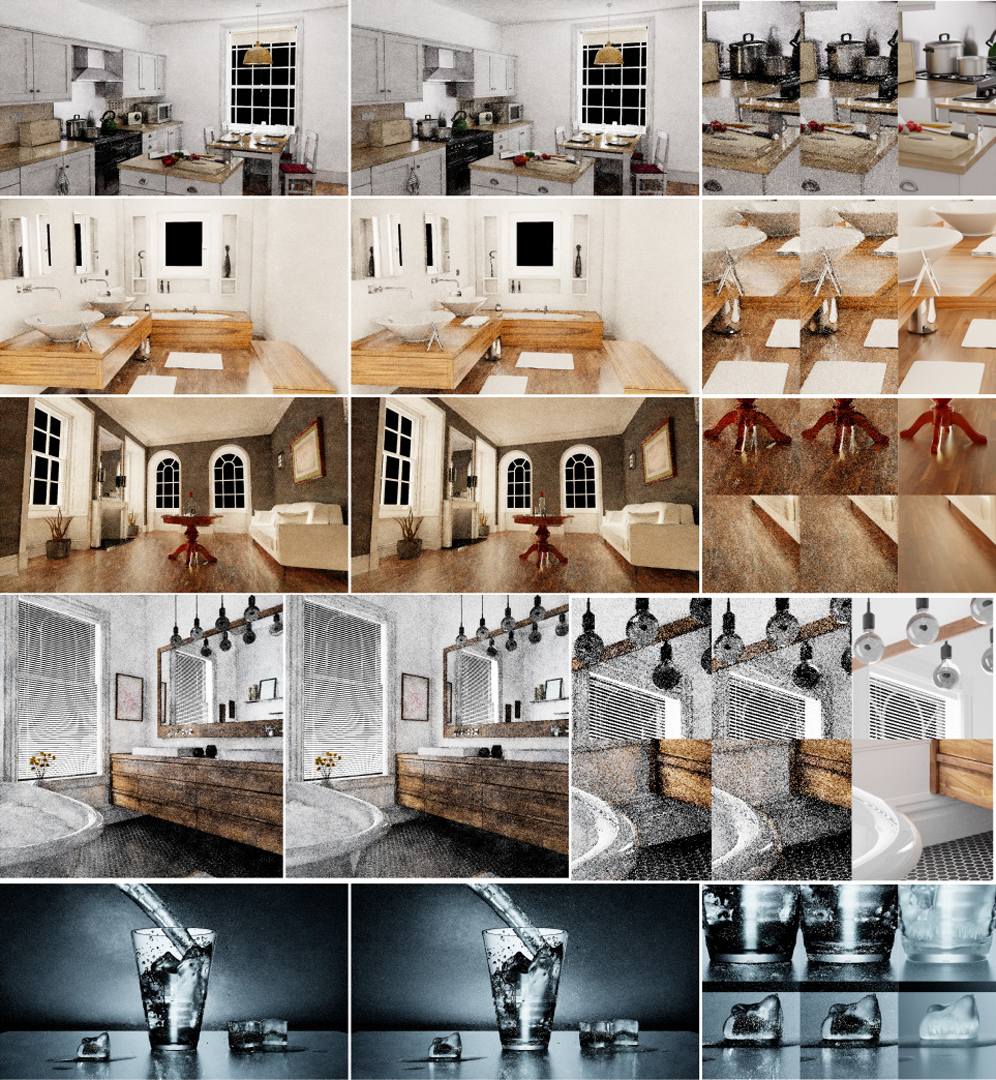“Reversible Jump Metropolis Light Transport Using Inverse Mappings” by Bitterli, Jakob, Novák and Jarosz
Conference:
Type(s):
Title:
- Reversible Jump Metropolis Light Transport Using Inverse Mappings
Session/Category Title: Volume Rendering and Global Illumination
Presenter(s)/Author(s):
Moderator(s):
Abstract:
We study Markov Chain Monte Carlo (MCMC) methods operating in primary sample space and their interactions with multiple sampling techniques. We observe that incorporating the sampling technique into the state of the Markov Chain, as done in Multiplexed Metropolis Light Transport, impedes the ability of the chain to properly explore the path space, as transitions between sampling techniques lead to disruptive alterations of path samples. To address this issue, we reformulate Multiplexed MLT in the Reversible Jump MCMC framework (RJMCMC) and introduce inverse sampling techniques that turn light paths into the random numbers that would produce them. This allows us to formulate a novel perturbation that can locally transition between sampling techniques without changing the geometry of the path, and we derive the correct acceptance probability using RJMCMC. We investigate how to generalize this concept to non-invertible sampling techniques commonly found in practice, and introduce probabilistic inverses that extend our perturbation to cover most sampling methods found in light transport simulations. Our theory reconciles the inverses with RJMCMC yielding an unbiased algorithm, which we call Reversible Jump MLT. We verify the correctness of our implementation in canonical and practical scenarios and demonstrate improved temporal coherence, decrease in structured artifacts, and faster convergence on a wide variety of scenes.
References:
- George E. P. Box and Mervin E. Muller. 1958. A note on the generation of random normal deviates. Ann. Math. Stat. 29, 2 (06 1958), 610–611. DOI:http://dx.doi.org/10.1214/aoms/1177706645?
- David Cline, Justin Talbot, and Parris Egbert. 2005. Energy redistribution path tracing. ACM Trans. Graph. 24, 3 (July 2005), 1186–1195. DOI:http://dx.doi.org/10.1145/1073204.1073330?
- Peter J. Green. 1995. Reversible jump markov chain monte carlo computation and Bayesian model determination. Biometrika 82 (1995), 711–732.?
- Adrien Gruson, Micka?l Ribardi?re, Martin ?ik, Ji?? Vorba, R?mi Cozot, Kadi Bouatouch, and Jaroslav K?iv?nek. 2017. A spatial target function for metropolis photon tracing. ACM Trans. Graph. 36, 1, Article 4 (Feb. 2017), 13 pages. DOI:http://dx.doi.org/10.1145/2963097?
- Toshiya Hachisuka and Henrik Wann Jensen. 2011. Robust adaptive photon tracing using photon path visibility. ACM Trans. Graph. 30, 5, Article 114 (Oct. 2011), 11 pages. DOI:http://dx.doi.org/10.1145/2019627.2019633?
- Toshiya Hachisuka, Anton S. Kaplanyan, and Carsten Dachsbacher. 2014. Multiplexed metropolis light transport. ACM Trans. Graph. 33, 4, Article 100 (July 2014), 10 pages. DOI:http://dx.doi.org/10.1145/2601097.2601138?
- Johannes Hanika, Anton Kaplanyan, and Carsten Dachsbacher. 2015. Improved half vector space light transport. Comput. Graph. Forum 34, 4 (2015), 65–74. DOI:http://dx.doi.org/10.1111/cgf.12679?
- Wilfred K. Hastings. 1970. Monte carlo sampling methods using markov chains and their applications. Biometrika 57, 1 (1970), 97–109. DOI:http://dx.doi.org/10.1093/biomet/57.1.97?
- Jared Hoberock and John C. Hart. 2010. Arbitrary importance functions for metropolis light transport. In Computer Graphics Forum. 1993–2003. DOI:http://dx.doi.org/10.1111/j.1467-8659.2010.01713.x?
- Wenzel Jakob. 2013. Light Transport on Path-Space Manifolds. Ph.D. thesis. Cornell University.
- James T. Kajiya. 1986. The rendering equation. In Proceedings of the SIGGRAPH Conference on Computer Graphics, Vol. 20. ACM, 143–150. DOI:http://dx.doi.org/10.1145/15922.15902?
- Anton S. Kaplanyan, Johannes Hanika, and Carsten Dachsbacher. 2014. The natural-constraint representation of the path space for efficient light transport simulation. ACM Trans. Graph. 33, 4, Article 102 (July 2014), 13 pages. DOI:http://dx.doi.org/10.1145/2601097.2601108?
- Csaba Kelemen, L?szl? Szirmay-Kalos, Gy?rgy Antal, and Ferenc Csonka. 2002. A simple and robust mutation strategy for the metropolis light transport algorithm. Comput. Graph. Forum 21, 3 (2002), 531–540. DOI:http://dx.doi.org/10.1111/1467-8659.t01-1-00703?
- Shinya Kitaoka, Yoshifumi Kitamura, and Fumio Kishino. 2009. Replica exchange light transport. Comput. Graph. Forum 28, 8 (Dec. 2009), 2330–2342. DOI:http://dx.doi.org/10.1111/j.1467-8659.2009.01540.x?
- Eric P. Lafortune and Yves D. Willems. 1993. Bi-directional path tracing. In Proceedings of the 3rd International Conference on Computational Graphics and Visualization Techniques (COMPUGRAPHICS?93). 145–153.
- Eric P. Lafortune and Yves D. Willems. 1996. Rendering participating media with bidirectional path tracing. In Proceedings of the Eurographics Workshop on Rendering: Rendering Techniques. Springer-Verlag, 91–100.?
- Jaakko Lehtinen, Tero Karras, Samuli Laine, Miika Aittala, Fr?do Durand, and Timo Aila. 2013. Gradient-domain metropolis light transport. ACM Trans. Graph. 32, 4, Article 95 (July 2013), 12 pages. DOI:http://dx.doi.org/10.1145/2461912.2461943?
- Tzu-Mao Li, Jaakko Lehtinen, Ravi Ramamoorthi, Wenzel Jakob, and Fr?do Durand. 2015. Anisotropic gaussian mutations for metropolis light transport through hessian-hamiltonian dynamics. ACM Trans. Graph. 34, 6, Article 209 (Oct. 2015), 13 pages. DOI:http://dx.doi.org/10.1145/2816795.2818084?
- Hisanari Otsu, Anton S. Kaplanyan, Johannes Hanika, Carsten Dachsbacher, and Toshiya Hachisuka. 2017. Fusing state spaces for markov chain monte carlo rendering. ACM Trans. Graph. 36, 4, Article 74 (2017), 74:1–74:10 pages.
- Jacopo Pantaleoni. 2017. Charted metropolis light transport. ACM Trans. Graph. 36, 4, Article 75 (2017), 75:1–75:15 pages.
- Martin ?ik, Hisanari Otsu, Toshiya Hachisuka, and Jaroslav K?iv?nek. 2016. Robust light transport simulation via metropolised bidirectional estimators. ACM Trans. Graph. 35, 6, Article 245 (Nov. 2016), 12 pages. DOI:http://dx.doi.org/10.1145/2980179.2982411?
- Eric Veach and Leonidas Guibas. 1994. Bidirectional estimators for light transport. In Proceedings of the Eurographics Workshop on Rendering: Photorealistic Rendering Techniques. 147–162. DOI:http://dx.doi.org/10.1007/978-3-642-87825-1_11?
- Eric Veach and Leonidas J. Guibas. 1995. Optimally combining sampling techniques for monte carlo rendering. In Proceedings of the Annual Conference Series on Computer Graphics. ACM, New York, NY, 419–428. DOI:http://dx.doi.org/10.1145/218380.218498?
- Eric Veach and Leonidas J. Guibas. 1997. Metropolis light transport. In Proceedings of the Annual Conference Series on Computer Graphics. ACM Press/Addison-Wesley Publishing Co., 65–76. DOI:http://dx.doi.org/10.1145/258734.258775?
- E. Woodcock, T. Murphy, P. Hemmings, and T. Longworth. 1965. Techniques used in the GEM code for monte carlo neutronics calculations in reactors and other systems of complex geometry. In Proceedings of the Conference on Applications of Computing Methods to Reactor Problems. 557–579.






